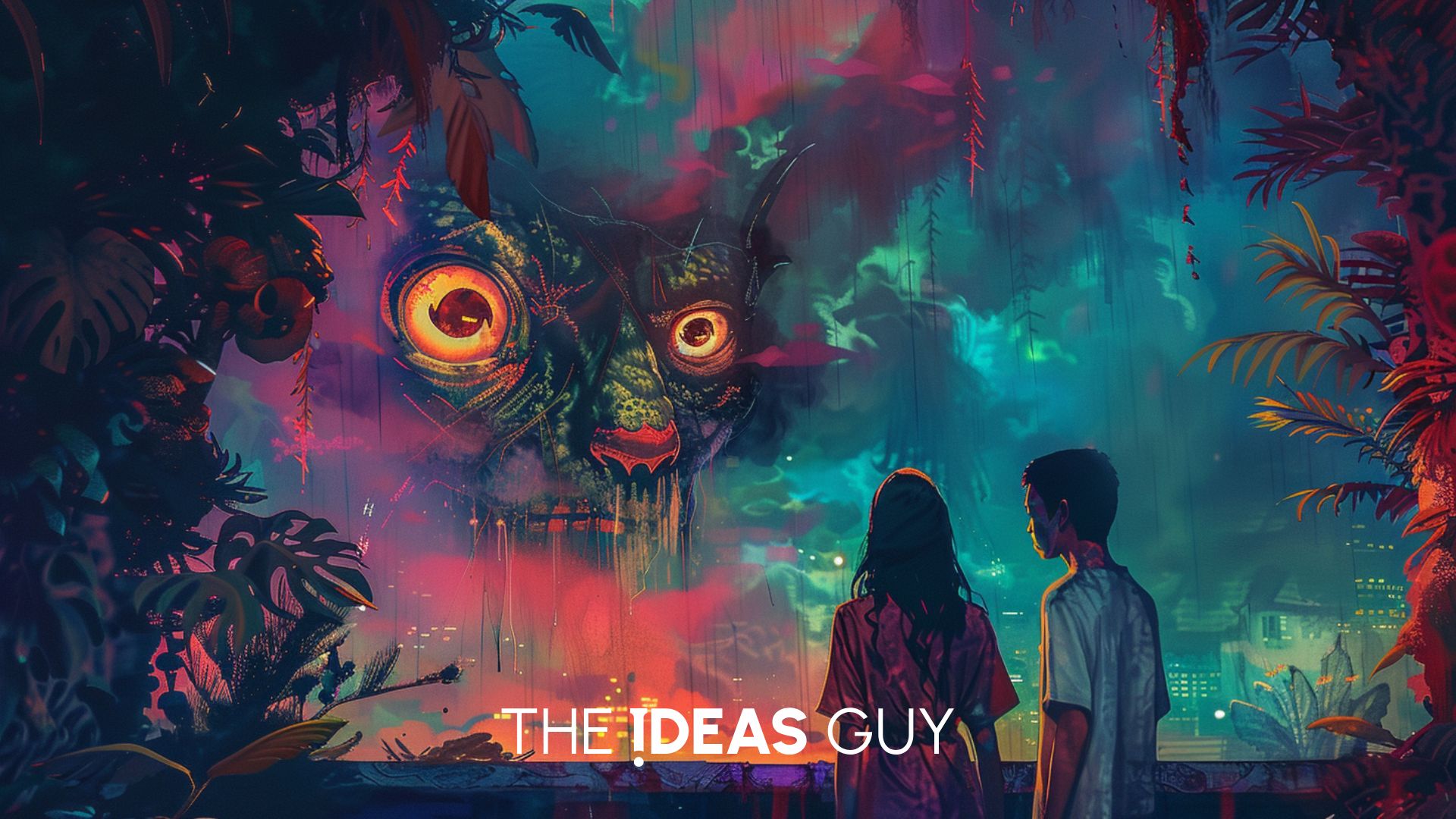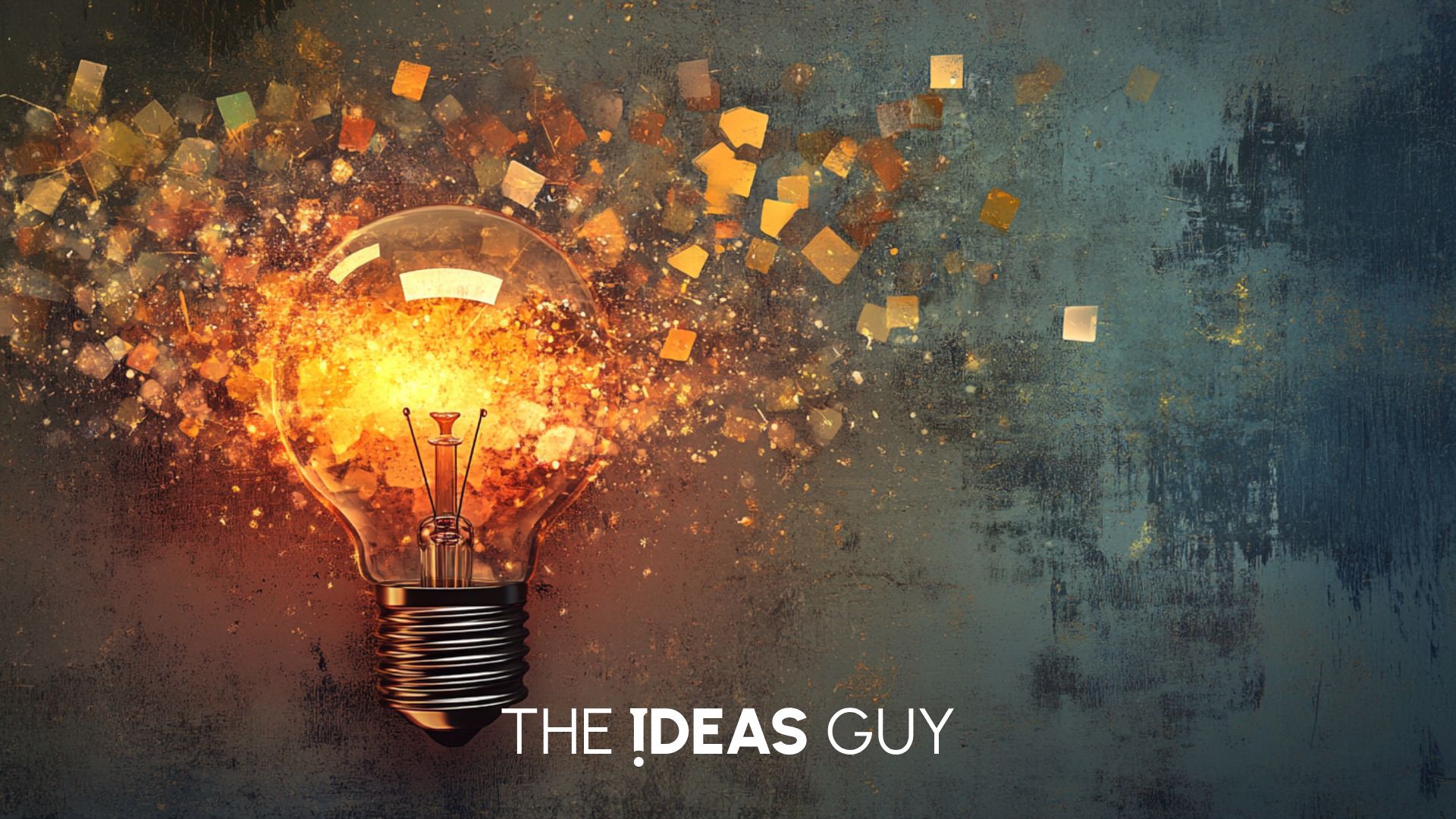One hundred articles. Roughly 300,000 words. Countless conversations, debates, and those 3am moments when an idea arrives uninvited and refuses to leave. As I mark this milestone, I’m not interested in just looking backward. Instead, I want to celebrate something more fundamental - the raw, transformative power of ideas themselves. In order to do that though, I want to reflect on what has been and how that has given life to new ideas.
Ideas are the birthplace of revolution. They drop into consciousness like bolts of lightning, illuminating landscapes we never knew existed. They’re the invisible architects of every meaningful change, from personal breakthroughs to societal transformation. An idea can redirect the entire trajectory of a life in the space between one heartbeat and the next.
Not just frameworks or methodologies (although I love these). Not life hacks or productivity systems (however much I am a fan of these). Ideas. Pure, dangerous, beautiful ideas that explode comfortable assumptions and rebuild understanding from the ground up.
These ten concepts have shaped how I think about leadership, creativity, relationships, education, innovation and the messy business of being human in an increasingly complex world. More importantly, they’ve proven themselves in the real world - not just in theory, but in the lives of people who’ve let them take root and grow. Me included.
Each one has the potential to change everything.
1. Your Identity Is a Story You Tell Yourself - And Stories Can Be Rewritten
We walk around convinced that our identity is carved in stone. “I’m not good with numbers”. “I’m not a creative person”. “I’m terrible at public speaking”. These statements feel like immutable facts, but they’re actually stories we’ve constructed about ourselves - and stories, by their very nature, can be edited. Even Natasha Bedingfield says so and that’s good enough for me. (I saw her in concert this summer at a festival - she was epic!)
The revelation came while watching a deputy headteacher transform herself from “tech dinosaur” to digital innovator. Not through willpower or positive thinking (although she had a shedload of those!), but by changing the narrative she told herself. Instead of “I don’t understand technology”, she began saying “I’m learning to use technology to help my students”. The shift seemed trivial, but the results were profound.
A friend of mine, Tamia Vassallo, told me something that has grabbed me and not let me go,
“Be careful what you tell yourself because you’re listening.” Tamia Vassallo.
This connects to Carol Dweck’s groundbreaking work on growth mindset which I refer to often in FRiDEAS. Dweck found that people who believe abilities can be developed consistently outperform those who view talents as fixed traits. I’ve explored this transformation of identity in depth when writing about unpeeling the layers of who we are - how we construct and reconstruct our sense of self throughout our lives (click the image below to have a read of this article).

Our brains are pattern-recognition machines that look for evidence to confirm existing beliefs about ourselves. When we tell ourselves, “I’m not creative”, we unconsciously filter out evidence of our creativity while amplifying instances that confirm our limitations. Change the story, and we change what evidence gets noticed.
Within six months, this “tech dinosaur” was experimenting with AI for lesson planning, attending webinars on educational technology, and had become her school’s informal digital advisor. Not because she developed new skills - because she developed a new story about herself that made skill development inevitable.
Our current identity isn’t our ultimate destiny. It’s our current draft.
“In the fixed mindset, everything is about the outcome. If you fail - or if you’re not the best - it’s all been wasted. The growth mindset allows people to value what they’re doing regardless of the outcome. They’re tackling problems, charting new courses, and working on important issues. “Maybe they haven’t found the cure for cancer, but the search was deeply meaningful.” Carol Dweck
2. Discomfort Is Data, Not Always a Problem to Solve
Western culture has developed an almost pathological aversion to discomfort. We’ve built entire industries dedicated to eliminating awkwardness, uncertainty, and emotional difficulty. But what if discomfort isn’t the enemy? What if it’s actually valuable information we’re systematically ignoring?
This shift in perspective transforms how we approach everything from difficult conversations to career decisions. Instead of immediately trying to resolve discomfort, we start treating it as data about misalignment, growth opportunities, or hidden problems requiring attention.
This principle echoes the Stoic philosophy I’ve written about extensively - the idea that our responses to circumstances matter more than the circumstances themselves. As Marcus Aurelius noted,
“You have power over your mind - not outside events. Realise this, and you will find strength.” Marcus Aurelius
A college head of division was struggling with giving honest feedback to underperforming staff. The conventional response would be to avoid the conversation or soften the message until it became meaningless. Instead, he investigated what the discomfort was telling him. Sometimes it revealed that he needed more evidence before proceeding. Other times it highlighted his own uncertainty about standards. Occasionally, it indicated that the lecturer was struggling with personal issues requiring support rather than criticism.
The discomfort wasn’t the problem - it was the early warning system.
This applies beyond professional contexts. The unease we feel in certain social situations might be highlighting value mismatches. The discomfort when considering a career change could indicate either fear of the unknown (worth pushing through) or genuine concerns about fit (deserving exploration).
The practice is simple but important. When we feel uncomfortable, pause before trying to eliminate the feeling. Ask what this discomfort might be trying to tell us. What information is embedded in this emotional response?
Sometimes the answer is that we need to push through irrational fear. Other times, it’s that something genuinely needs our attention.
I wrote about my eldest daughter who showed incredible resilience despite the data telling her that she was in the wrong place. If you haven’t yet read it, click the image below to read more

3. Excellence Is About Subtraction, Not Addition
We live in an addition-obsessed culture. More skills, more qualifications, more connections, more strategies. More stuff that we don’t need. The dominant narrative suggests excellence comes from accumulating competencies and consumables until we’ve covered all possible bases.
This is backwards. True excellence emerges from relentless subtraction - identifying what matters most and eliminating everything else.
“The difference between successful people and really successful people is that really successful people say no to almost everything." Warren Buffett.
Warren Buffett understood this with his “25-5 rule” - write down your top 25 goals, circle the top 5, then avoid the remaining 20 at all costs. Not “work on them when you have time” but actively avoid them. Those 20 items aren’t just less important - they’re the enemy of excellence because they dilute focus from what truly matters.

This mirrors what I’ve explored in my article about authenticity in the age of conformity - the courage to resist the pressure to be everything to everyone and instead commit fully to what genuinely matters. I also loved writing about this in the article about The Dragon and the Mirror.
A primary school teacher was drowning in extracurricular responsibilities - after-school clubs, curriculum committees, playground duties, event organisation, and parent engagement initiatives. She was competent at all of them but excellent at none because she didn’t have time to do them all as well as she wanted. When she identified her core strength - developing struggling readers - and systematically eliminated other commitments, her impact multiplied exponentially. Within two years, she’d become the reading specialist for her entire trust.
Excellence isn’t about being good at everything. It’s about being exceptional at the few things that genuinely matter, which requires saying no to almost everything else.
The challenge isn’t identifying what to add to our repertoire. It’s having the courage to subtract everything that dilutes our focus, something I talked about in The Power of No.
4. Vulnerability Is Strategic Advantage, Not Weakness
In Britain, we celebrate the stiff upper lip and view exposure of weakness as career suicide. Yet research consistently shows that leaders who demonstrate appropriate vulnerability - admitting mistakes, acknowledging uncertainty, asking for help - build stronger teams and achieve better results.
The key word is “appropriate.” This isn’t emotional dumping or oversharing personal struggles (and haven’t I learned that the hard way!). It’s strategic transparency that builds trust and psychological safety.
A trust leader I coached had built his reputation on never being wrong. He had an answer for everything, a solution to every problem, and projected unwavering confidence in all decisions. His staff respected his competence but didn’t trust him with their uncertainties or mistakes. Innovation stagnated because people feared exposing gaps in their knowledge.
Everything changed when he began a team meeting by saying, “I need to admit that I’m not sure how to handle the new SEND requirements. I’ve been pretending I have it sorted, but I don’t. I think we need to figure this out together.” The shift in room dynamics was immediate, he told me. Within weeks, teachers were bringing problems forward instead of hiding them, sharing half-formed ideas instead of waiting for perfect solutions.
Vulnerability works because it signals psychological safety. When leaders acknowledge their limitations, it gives others permission to be human. When experts admit uncertainty, it creates space for collective problem-solving.
It is tied to Marianne Williamson’s brilliant poem that I used in the introduction to my book, Our Deepest Fear. We let our light shine by bringing dark things into the light.
This aligns with Brené Brown’s research on courage and connection, which reveals that vulnerability isn’t weakness but the birthplace of innovation, creativity, and change. I’ve written about this in my piece on cutting through communication noise - how authentic connection requires the courage to be genuinely seen.

The practical application requires calibration. Vulnerability should be purposeful, not reflexive. It should invite collaboration, not create anxiety. And it should demonstrate strength through honesty, not weakness through oversharing.
When properly applied, vulnerability becomes a superpower that transforms relationships, teams, and outcomes.
5. Systems Thinking - Everything Is Connected to Everything Else
Most problems exist within systems, yet we consistently try to solve them in isolation. We treat symptoms while ignoring causes, address individual components while missing systemic patterns, and wonder why our solutions keep failing.
Systems thinking represents a fundamental shift from linear to circular causality. Instead of asking “What caused this problem?” we ask “What patterns of interaction created this situation?” Instead of seeking the root cause, we look for leverage points where small changes might create disproportionate improvements.
This echoes what I’ve written about in my exploration of Dannemiller’s Formula for Change - how sustainable transformation requires understanding the interconnected forces that maintain current patterns. I also talked about it in the article on First Principles Thinking.

A small business I worked with was struggling with poor return on their digital marketing investment. The conventional approach would examine individual factors separately - ad copy quality, targeting parameters, landing page design, budget allocation across platforms. Systems thinking revealed something different - their sales team wasn’t following up leads within 24 hours because they were overwhelmed with administrative tasks, so even high-quality leads went cold. Meanwhile, their website asked for too much information upfront (deterring conversions), their CRM system didn’t integrate with their advertising platforms (making attribution impossible), and their business owner kept slashing the marketing budget whenever cash flow tightened - precisely when consistent presence mattered most. The whole system was sabotaging itself. Redesigning the lead handoff process, simplifying the website forms, integrating systems so data flowed properly, and ring-fencing a minimum marketing spend addressed the ROI problem more effectively than any amount of ad optimisation or creative refinement.
This applies to personal effectiveness as well as it does to technical elements in a business. Productivity isn’t just about time management - it’s about energy management, decision-making frameworks, environmental design, relationship quality, and value clarity. Optimising any single element provides limited improvement. Understanding how they interact enables transformation.
The practical shift is moving from “How do I fix this?” to “What system is producing this outcome, and where might I intervene to change the pattern?”
6. Attention Is Our Most Valuable Currency
In an economy where information is abundant and attention is scarce, our ability to focus has become our most valuable asset. Yet most people treat attention as infinite and carelessly squander it on trivial pursuits.
Attention isn’t just about productivity - it shapes the quality of our experiences, relationships, and ultimately, our life. What we pay attention to literally becomes our reality. The person who spends hours consuming outrage-inducing news develops a fundamentally different worldview than someone who dedicates the same time to learning about solutions and innovations.
The breakthrough came during a particularly intense work period when I realised I wasn’t managing my attention - I was letting it be hijacked by whatever felt most urgent. The solution wasn’t time management but attention architecture - designing environment and routines to protect and direct focus toward what genuinely mattered.
This meant batch-processing emails instead of responding immediately, using Do Not Disturb on my Mac during deep work periods, and creating physical spaces optimised for different types of thinking. But attention management goes deeper than productivity techniques. It’s about intentionally curating what fills our mental space.
The books we read, podcasts we listen to, conversations we engage in, and people we spend time with all shape our internal landscape. Successful people aren’t necessarily smarter or more talented - they’re often simply better at directing their attention toward activities that compound over time rather than dissipating energy on distractions.
This connects to Johann Hari’s work on focus, which I’ve explored in my analysis of the twelve thieves of attention - how our environment systematically hijacks our ability to concentrate, making intentional attention management not just helpful but essential for cognitive health.
Our attention is our life. Where we direct it determines who we become.

7. Questions Are More Powerful Than Answers
Education and professional culture have conditioned us to value answers over questions. We reward people who can provide solutions, demonstrate expertise, and display certainty. But as the world is now one of accelerating change and genuine complexity, the ability to ask better questions has become more valuable than the ability to provide correct answers.
Questions shape thinking in ways that answers cannot. A good question opens up possibilities, challenges assumptions, and creates space for insights to emerge. Answers, even correct ones, often close down exploration and limit creative potential.
This principle underlies my Unboxing Ideas Framework - a structured approach to creative problem-solving that puts the power of questioning at its centre.
Instead of trying to provide solutions for every challenge, I began focusing on helping people develop better questions. Instead of asking “How do I motivate my team?” they learned to ask “What conditions would naturally inspire engagement?” Instead of “How do I manage my time better?” they explored “What am I optimising for, and does my calendar reflect those priorities?”
The quality of our questions determines the quality of our thinking. Shallow questions produce shallow insights. Powerful questions generate breakthrough understanding.
This applies to personal development as well. Instead of “How can I be happier?” try “What activities make me lose track of time?” Instead of “How do I find my passion?” Consider “What problems am I naturally drawn to solving?” The reframed questions elicit different information and often reveal unexpected directions.
Before seeking answers, examine whether we’re asking the right questions. Often, apparent problems dissolve when reframed through better questioning.
8. Failure Is Feedback, Not Judgement
Our relationship with failure determines our capacity for growth, innovation, and resilience. Yet most people treat failure as evidence of inadequacy rather than information about what doesn’t work.
This reframe isn’t just psychological comfort - it’s strategically essential. In fields requiring innovation or complex problem-solving, the ability to fail fast, extract learning, and iterate quickly provides enormous competitive advantage.
The transformation happens when we shift from “I failed” to “That approach failed.” The first statement makes failure about identity; the second makes it about strategy. This distinction preserves self-worth while enabling objective analysis of what didn’t work and why.
A deputy head who’d been paralysed by fear of making mistakes began treating every decision as an experiment. Some experiments succeeded; others provided valuable data about what to avoid. The key was extracting learning from both outcomes instead of letting failures undermine confidence. This mirrors what I explored in my article on managing expectations and how viewing unmet expectations as feedback rather than failure transforms our relationship with setbacks.

Teachers who treat unsuccessful lessons as data about what students need rather than evidence of their own incompetence become more effective educators. Leaders who view failed initiatives as information about market conditions or organisational capabilities make better strategic decisions.
This doesn’t mean celebrating failure or being careless with decisions. It means creating learning systems that extract maximum value from both successes and setbacks.
9. Our Environment Shapes Our Behaviour More Than Our Willpower
Most self-improvement advice focuses on internal factors - developing discipline, building willpower, changing mindset. But environmental psychology reveals something profound - context shapes behaviour more powerfully than conscious intention.
The people around us, the physical spaces we inhabit, the tools we use, and the systems we operate within all exert invisible influence on our choices. Instead of fighting against environmental pressures through willpower, successful people engineer environments that naturally support their desired behaviours.
Instead of relying on motivation to overcome distractions, I created a dedicated writing space with no internet access, moved social media apps into folders off the home screen on my phone, and established routines that made writing the path of least resistance. The environmental changes were more effective than any amount of self-discipline.
The same principle applies to teams and organisations. Instead of trying to motivate people to collaborate more effectively, successful leaders remove barriers to collaboration - creating shared spaces, aligning incentives, and establishing processes that make cooperation easier than competition.
Environmental design works because it reduces the cognitive load required for good decisions. When healthy food is easily accessible and junk food requires effort to obtain, we naturally eat better without conscious decision-making.
We should examine our environment and honestly assess whether it supports or undermines our goals. Then systematically modify contexts to make success more likely than failure.
10. Meaning Is Created, Not Found
Perhaps the most transformative realisation is that meaning isn’t something we discover through introspection or stumble upon through experience. Meaning is something we actively create through the stories we tell about our experiences, the values we choose to embody, and the impact we decide to pursue.
This insight demolishes the anxiety-inducing myth that everyone has a predetermined “purpose” they must find. It replaces passive searching with active construction. Instead of waiting for our calling to reveal itself, we can begin creating meaning immediately through the choices we make and the narrative we construct about our life.
Viktor Frankl, drawing from his experiences in concentration camps, understood that meaning could be created even in the most horrific circumstances and I feel like he has played a part in so many FRiDEAS articles that it might be overkill! But he identified that people who maintained purpose weren’t those who found inherent meaning in suffering, but those who chose to create meaning through their response to circumstances.
This principle liberated me from years of searching for my “true calling.” Instead of waiting for passion to strike, I began creating meaning through work that utilised my strengths, addressed problems I cared about, and contributed to outcomes I valued. Purpose emerged from practice, not revelation.
As I wrote in my deeply personal piece on unpeeling life’s layers mentioned above as well as the multiple-part pieces about Living with ADHD, meaning-making becomes particularly crucial when facing life’s most difficult challenges - it’s what allows us to integrate experiences rather than being broken by them.
The practical shift is moving from “What is my purpose?” to “How can I create meaning in what I’m already doing?” This doesn’t mean accepting unsatisfying circumstances indefinitely, but it means taking ownership of the meaning-making process instead of waiting for external validation.
We don’t find our purpose - we build it, one meaningful choice at a time.
.jpg)
The Compound Effect of Ideas
These ten ideas aren’t isolated insights but interconnected principles that amplify each other. Understanding that identity is constructed makes it easier to embrace failure as feedback. Recognising attention as currency helps us create environments that support our goals. Treating discomfort as data enables us to build meaning through difficulty.
Ideas have explosive power when properly understood and applied. They don’t just change what we think - they transform how we think, which ultimately determines what becomes possible in our lives.
The most rewarding responses to these articles haven’t been “Thanks for the tips” but “You’ve changed how I see this completely.” That’s the transformative power of ideas - they don’t just provide solutions to existing problems, they reveal problems we didn’t know we had and possibilities we couldn’t previously imagine.
The real magic happens when ideas move from intellectual understanding to embodied practice. When they stop being concepts we agree with and become lenses through which we naturally see the world.
Here’s to the next hundred articles, and more importantly, to the dangerous, transformative ideas yet to be explored. Because in a world that desperately needs fresh thinking, the most radical act might simply be the willingness to let a powerful idea change everything.
Further Reading
Discover more interesting articles here.
.png)

.jpg)

